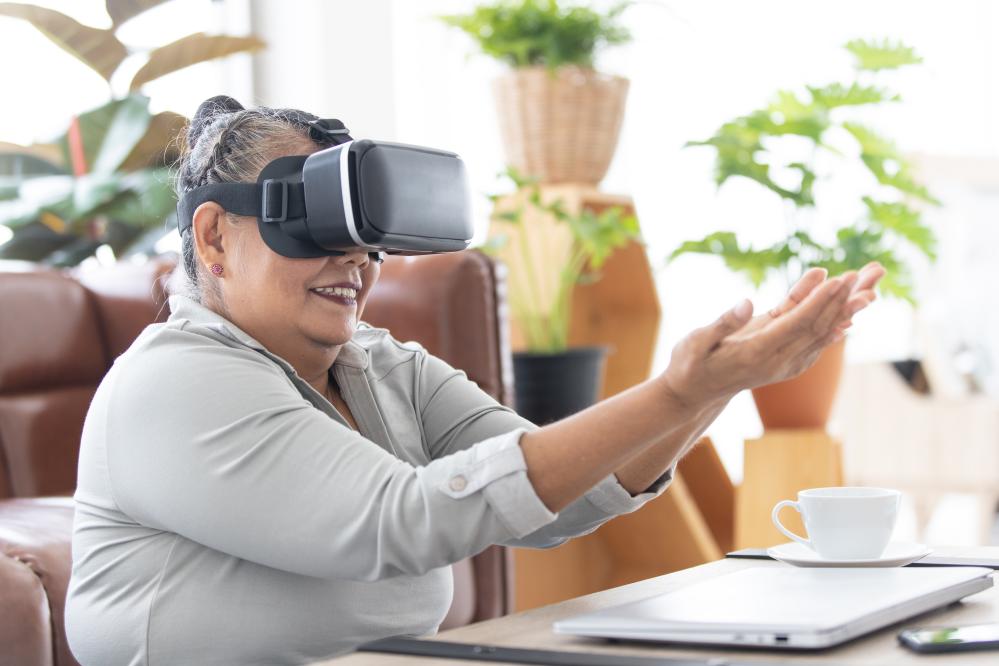Researching novel technology solutions to support social and cognitive engagement

Theories of successful aging point to the crucial role of social connections in promoting health, quality of life, and wellbeing. However, in the United States about 20% of men and 33% of women age 65 and older live alone, putting them at risk for social isolation. Age-related changes in health, mobility, employment status, and social network size can also increase isolation risk.
A question that has emerged, especially during the pandemic, has been how well technology can provide meaningful social support remotely, and whether technology-mediated social interactions can have the same or similar impacts on health and wellbeing as in-person interactions. Our research group, as part of the CREATE and ENHANCE Centers, has examined these questions using traditional technology platforms – computers, tablets, smartphones, etc. However, increasingly, researchers are beginning to explore novel technology solutions, including immersive virtual reality (VR) and augmented reality (AR) solutions, as being able to provide meaningful social support and cognitive engagement, especially for older adults at risk for social isolation.
We have shown that access to a simple-to-use computer system, designed specifically for older adults with little previous computer experience, can make a difference. The Personal Reminder Information and Social Management (PRISM) system field trial assigned 300 older adults living alone to either an intervention group that received our computer system or a control group that received a paper informational binder. The computer offered email, a buddy list, access to local and national resources, and games. After six months the computer group reported significantly less loneliness and increased social support and well-being compared to the control group, though these effects largely dissipated by 12 months. The computer group, however, also demonstrated more positive attitudes toward computers at the end of the trial, as well as substantially increased computer proficiency. These improvements were maintained during the entire length of the year-long trial.
Can virtual and augmented reality provide more meaningful social support compared to traditional technology-based social interactions such as phone or email communications? There are reasons to believe so. Virtual-reality headsets can imbed two people at distant locations in the same virtual space. They can see a representation (i.e., avatar) of the other person, have a conversation, and even engage in creative activities together (e.g., creating a virtual piece of art). Or in the example of augmented reality, the technology can superimpose a representation of the distant person onto the real environment of the other user.
Intuitively, these immersive, rich, and real-time interactions would seem ideal for promoting social connections and reducing loneliness, but, so far, data are scarce. Large-scale clinical trials testing these hypotheses are needed. However, based on real-world usage data at least some people appear to find meaningful social experiences through VR technology. As I write this blog post at 10 a.m. on a Wednesday morning, there are currently more than 17,000 users logged on to VRChat, one of the most popular social VR programs. Peak usage last year was 42,564 simultaneous users from all around the world chatting, exploring, watching movies together, and playing games in the different virtual worlds hosted by VRChat.
As with all technology solutions, important questions arise related to the age-related “digital divide.” Older adults on average adopt and use new technologies less compared to younger adults, have more negative attitudes towards technology, and on average are less technology proficient. Would these differences serve as barriers to older adults’ use of VR to support social connections and cognitive engagement? Initial studies conducted by our research team suggest that usability issues are not a major problem after initial training with a commercial VR headset. In fact, there is evidence that older adults experience virtual reality as more immersive compared to younger adults. In a recent study comparing older adults with and without mild cognitive impairment (MCI), our research group had participants engage in VR activities designed to improve mood. Participants experienced virtual nature scenes and planted their own virtual gardens. Mood improved after VR exposure, as did attitudes toward VR. Importantly, participants reported almost universally positive experiences and few issues using the technology.
Within simulated environments, “simulator sickness” is often a concern. Simulator sickness (also known as cybersickness) can result when there is a mismatch between the experience of visual motion and actual body movement and is associated with symptoms of nausea and headache. Although some studies suggest that simulator sickness can be greater in older adults compared to younger adults, all three of the studies described here found simulator sickness to be minimal in both younger and older adults tested.
Currently, there is a lot of potential for these emerging technologies to improve the lives of older adults. However, like all proposed technology solutions, this potential needs to be rigorously evaluated in large-scale studies. And this evaluation needs to focus not just on intervention efficacy (does the technology intervention work?) but also on intervention acceptability and feasibility (how do we design the technology to be appealing and easy-to-use?). Safety is a crucial factor to consider as well. VR headsets obscure vision with the potential to increase fall risk should careful countermeasures not be in place, an important consideration for older adults experiencing balance problems or increased frailty.
This is an exciting time for gerontechnologists, as the emergence of new technologies open new lines of exploration and allow for the discovery of novel interventions to support and enhance older adults’ independence, health, social connectedness, and quality of life.













